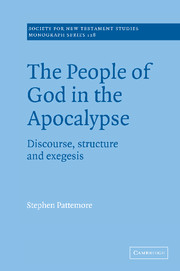Book contents
- Frontmatter
- Contents
- List of figures and table
- Preface
- List of abbreviations
- 1 A question of relevance
- 2 Relevance Theory in biblical interpretation
- 3 A cognitive environment for the Apocalypse
- 4 Souls under the altar – a martyr ecclesiology
- 5 Companions of the Lamb – a messianic ecclesiology
- 6 The New Jerusalem, bride of the Lamb
- 7 Summary and conclusions
- Appendix: Abbreviated discourse outline
- Bibliography
- Index
7 - Summary and conclusions
Published online by Cambridge University Press: 22 September 2009
- Frontmatter
- Contents
- List of figures and table
- Preface
- List of abbreviations
- 1 A question of relevance
- 2 Relevance Theory in biblical interpretation
- 3 A cognitive environment for the Apocalypse
- 4 Souls under the altar – a martyr ecclesiology
- 5 Companions of the Lamb – a messianic ecclesiology
- 6 The New Jerusalem, bride of the Lamb
- 7 Summary and conclusions
- Appendix: Abbreviated discourse outline
- Bibliography
- Index
Summary
Review
The object of this study has been to investigate the depictions of the people of God as actors in the drama portrayed by John's second main vision description (Rev. 4:1–22:9), and to understand how his audience, whether conceived of as members of the seven churches, or as a wider and less clearly defined group of addressees, would have identified with these portrayals. Further, we have sought to discover in what directions these real Asian Christians would have been moved to ‘keep the words of this book’.
The distinctive methodology of the study has been the use of Relevance Theory, not as a replacement for existing methodologies, but as providing a sharper criterion for their application. A Relevance-Theoretic approach to investigating how a text would have been understood requires a knowledge of the various factors which contribute to the cognitive environment of the author and audience, and a relevance-sensitive appreciation of the internal structure of the text itself. While context in RT is not pre-defined but accessed progressively as a text unfolds, it was necessary to state a set of starting assumptions concerning the communication situation in which the Apocalypse had its origins (section 3.2). Results of detailed study of the internal structure of the text, using the optimization of relevance as an important criterion, were reported in brief (section 3.3).
- Type
- Chapter
- Information
- The People of God in the ApocalypseDiscourse, Structure and Exegesis, pp. 213 - 219Publisher: Cambridge University PressPrint publication year: 2004



